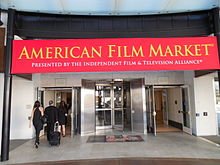This is an old revision of this page, as edited by AlviseFalier (talk | contribs) at 11:28, 14 December 2015. The present address (URL) is a permanent link to this revision, which may differ significantly from the current revision.
Revision as of 11:28, 14 December 2015 by AlviseFalier (talk | contribs)(diff) ← Previous revision | Latest revision (diff) | Newer revision → (diff)| This article includes a list of general references, but it lacks sufficient corresponding inline citations. Please help to improve this article by introducing more precise citations. (October 2014) (Learn how and when to remove this message) |
The American Film Market (AFM) is a film industry event and trade show held each year at the beginning of November in Santa Monica, California.

About 8,000 people attend the eight day event to network and to sell, finance and acquire films. Participants come from more than 70 countries and include acquisition and development executives, agents, attorneys, directors, distributors, festival directors, financiers, film commissioners, producers, and writers, among others. Founded in 1981, the AFM quickly became one of the premier global marketplaces for the film business, where unlike a film festival, production and distribution deals are the main focus of the participants.
The AFM is held in Santa Monica at the Loews Santa Monica Beach Hotel (since 1991) and the Le Merigot Beach Hotel which are both converted into a busy marketplace of offices. In addition to the deal-making that occurs at the AFM there are screenings, conferences, networking events and parties.
The American Film Market uses movie theatres on Santa Monica's Third Street Promenade (and in the surrounding area) and high definition screening rooms in various hotels to accommodate 700 screenings of over 400 films (often world or U.S. premieres). The films shown range from mid-budget blockbusters that will be released by the major studios in the U.S., to lower budget art and genre films recognized at international film festivals, all seeking theatrical and television distribution throughout the world.
The AFM is produced by the Independent Film & Television Alliance (IFTA), the trade association representing the world's producers and distributors of independent motion pictures and television programs.
History
The American Film Market, or AFM, was first conceived during a luncheon in the summer of 1980 attended by five Los Angeles-based independent film distribution executives, fed up with the high costs, bribes and corruption at the Cannes Film Festival. Consequentially, in November 1980, a group of American content distributors invited foreign content buyers to La Costa a resort near Carlsbad, California.
The next year, AFM was organized as a March 24–31 market. The first AFM was held at the Westwood Marquis Hotel (now the W Hotel) in West Los Angeles. It housed 26 selling companies and registered a total of 1,000 participants. The following year, it moved to the nearby Holiday Inn on Wilshire Blvd, and in 1983, it was held at the Continental Hyatt Hotel (which has since become The Andaz), where it remained for three years before heading to the Beverly Hilton in 1986. In 1991, AFM moved to its current location at the Loews Hotel in Santa Monica.
While at the Beverly Hilton Hotel, in order to provide screening rooms for exhibitors, the market rented movie theaters in nearby Westwood Village and Beverly Hills. By 1990, the AFM relied on 20 screens in various cinemas. Today, in its Santa Monica location, the AFM can rent exhibitors some 26 screens across three nearby multiplex cinemas and four hotels.
Initially, the bulk of sales during the AFM were of pornographic films. Although sales of pornographic films were not officially allowed at the AFM, since many pornographic sellers were also producing and distributing mainstream movies, they could not be prevented from exhibiting.
In 1985, 60 percent of all foreign film sales done at the AFM were for home video rights. By 1990, theatrical sales resurged with 41.5 percent of sales, while video decreased to 32 percent. Four years later, free-TV sales accounted for 27 percent of the total, while theatrical sales were down to 30 percent.
By 2008, AFM had become primarily a DVD market, but two years later the majority of business reverted to television sales and the video on demand. Then, in 2013, AFM declared the DVD business basically dead, replaced by streaming. On the AFM opening day, Blockbuster Video announced the closing of its remaining 300 home video stores in the U.S., to be replaced by streaming service.
In order to keep costs at bay, in mid-2011, AFM organizers considered moving the market to downtown L.A., a move disliked by all participants, but avoided that with help from the city of Santa Monica, which put some pressure on the Loews Hotel. On December 8, 2011, AFM announced that it would remain in Santa Monica until at least 2017, ending months of speculation that it would move to LA Live in downtown Los Angeles.
The dates for the 2015 conference are November 4–11, 2015; future events will be held November 2–9, 2016 and November 1–8, 2017.
References
- ^ McNary, Dave (13 July 2015). "IFTA Renews Jean Prewitt, AFM Topper Jonathan Wolf". Variety. Retrieved 17 October 2015.
- VideoAge, Nov./Dec. 2008 Issue
- VideoAge, Nov./Dec. 2010 Issue
- VideoAge, Nov./Dec. 2013 Issue
- Variety, AFM to stay in Santa Monica thru 2017, http://www.variety.com/article/VR1118047213
External links
This article related to a film organization is a stub. You can help Misplaced Pages by expanding it. |